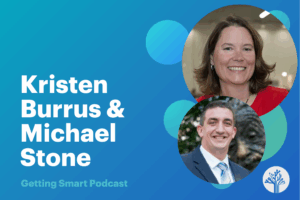Take A Judo Lesson, Leverage Trends To Make An Impact

As opportunity goes global, competence and initiative are valued more than ever. For individuals, communities and countries, getting smart is a priority.
Want to make a big impact? Take a judo lesson. First, rather than opposing strength, take advantage of momentum. Second, use levers to move big objects. That means change makers should be trend spotters and savvy about using levers like social media to bend trends toward equity.
Change forces, like technology, demographics, and politics, create windows of opportunity you can take advantage of if you are paying attention. There is usually a small window of time to build a solution, demonstrate some traction, and create something that, as my Learn Capital partner Rob Hutter says, “authentically delights a community of users.”
The Black Swan backdrop. The stock market is at record highs. The Dow reached 16,000 in December 2013 and 18,000 in December 2014. Consumer confidence is up, tax receipts and unemployment rates recovered to pre-recession levels. Real estate prices have rebounded in most areas. However, State K-12 education spending per pupil fell in 29 states since 2008. The need to do more with less continues. As Secretary Duncan announced in 2010, we now operate in a “new normal” age, one with the potential and need for “transformational productivity.”
Federal K-12 education policy (ESEA) should have been revised a decade ago and is badly out of date. It will eventually be reauthorized with less federal influence, and an unfortunate loss of bipartisan support for more equitable outcomes.
It’s a big complicated world. Our mental models can’t keep up. There are more black swan events–big bad stuff that no one predicted.
Despite broken politics, ineffective governance and bad surprises, new tools are powering a global learning revolution. Internet search and cheap devices means two billion people can learn just about anything and connect to the idea economy. After decades of neglect, $2 billion of venture investment flowed into EdTech startups last year. Foundations are supporting the development of new learning environments. School districts are ditching textbooks and phasing a digital conversion. Thoughtful blended learning implementations are producing promising results.
Below we recapped 30 relevant trends. The second table is a set of Judo instructions for impact investors and edupreneurs interested in leveraging some of those trends.
Trends Creating Opportunities & Challenges for U.S. Schools
| Demands | More poverty, English learners & special needs; broader & more demanding expectations |
| Students | Diverse, distracted, undisciplined; tolerant, enterprising & hyphenated |
| Employment | Increasing ROI on competence & initiative; expanding certification & alt signaling |
| Formative | Toward continuous feedback in most subjects, background data collection |
| Politics | Anti-federal; core unraveling, back to unique state standards |
| Authentic | Focus on engagement, more performance assessment, deeper learning |
| Curriculum | More free/open content & tools; more smart/adaptive content |
| Data | More recommendation engines driving playlists; dynamic scheduling |
| Summative | Half of state tests will be unique, no comparability; end of week long tests in sight |
| Access | Toward high access; schools purchasing devices (particularly web appliances); students bringing mobile devices to school (BYOD) |
| Strategies | Schools adopting personalized and blended learning strategies |
| Gamification | More learning games & game-based strategies built into apps/systems |
| Competency | Slow trend toward show what you know, progress on mastery |
| Systems | Shift to ubiquitous cloud computing (basic SIS & HRIS systems still suck) |
| Engagement | More project-based learning; focus on growth mindset |
| Investment | Growing VC & philanthropic spend on tools & next gen models |
| Tools | App explosion, many freemium, weak interoperability |
| Assistive | More assistive tech meeting special needs |
| Schools | Long trend toward platform-centric networks |
| Platforms | Slow shift from LMS to interoperable app ecosystems |
| Connections | More CTE and work-based options |
| Guidance | Personalized counseling & guidance, virtual mentoring, informed decision support |
| Budget | Tight in most state; squeezed by health & justice; toward weighted, flexible, portable funding |
| Options | More schools of choice, access to FT & PT online learning |
| Conditions | More teams & better support for teachers; more model variety |
| Careers | More options for educators; growth in remote teaching/services |
| Prep & PD | Toward blended, personalized, competency-based preparation and development |
| HigherEd | Declining ROI on 2nd tier degrees; more flexible, affordable competency-based options; more dual enrollment opportunities |
| Postsec | More job linked non-degree programs: code school, business skills |
| Productivity | Developed world need to do more with less; low cost models in developing world |
Big Impact Opportunities
| Demands | Vocabulary development & language acquisition tools (e.g., Ellevation, Newsela, Rosetta Stone); blended humanities |
| Students | Youth and family support systems |
| Employment | Badging, certification & alternative signaling systems |
| Politics | Sponsor innovative alternative (e.g. ReSchool Colorado) |
| Formative | Tools/standards for combining multiple sources of formative assessment |
| Authentic | R&D on writing feedback tools |
| Curriculum | Build and share open content |
| Data | Build/sponsor a data system, host a data competition |
| Summative | Sponsor/build innovative competency-based state measurement system |
| Access | Sponsor state matching fund to support 1:1 take home devices |
| Strategies | Sponsor/develop innovative blended learning school |
| Gamification | Game platform with a viable business model |
| Competency | K-12 badge system to manage competency-based progress |
| Systems | Build a decent HRIS |
| Engagement | Sponsor project/module authoring (e.g., LDC); support adoption of PBL platform |
| Investment | Advocate for investment that improves access and equity |
| Tools | Build/sponsor a portable LMS companion |
| Assistive | More assistive tech meeting special needs |
| Schools | Sponsor a platform-centric network (e.g., New Tech Network) |
| Platforms | Sponsor an interoperable app ecosystems; Build/sponsor smart demand |
| Connections | Sponsor CTE network (e.g., GPS Education Partners) |
| Guidance | Build/sponsor personalized counseling & guidance systems |
| Budget | Advocate for weighted, flexible, portable funding |
| Options | Advocate for quality options |
| Conditions | Pilot environments that provide better conditions & supports for teachers |
| Careers | Build/support portable micro-credentialing system |
| Prep & PD | Sponsor a teacher PD marketplace |
| HigherEd | Sponsor affordable competency-based option (e.g., College for America) |
| Postsec | More job linked non-degree programs: code school, business skills |
| Productivity | Developed low cost models (e.g., Bridge International) |






Brian Silberberg
This is a great list to conceptualize all of the useful tools being used to shake up the education game in America. At Books That Grow we're committed to being a part of just that. Our app provides a library of reading materials, each of which can be read across multiple reading levels, to ensure all students can have their needs accommodated simultaneously. See more at http://www.booksthatgrow.com/